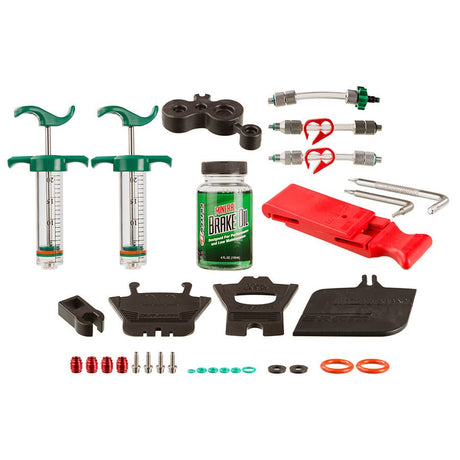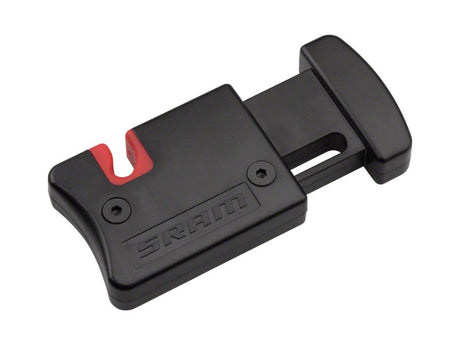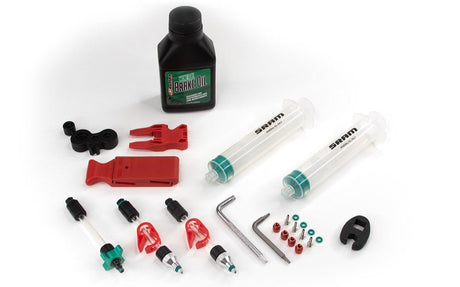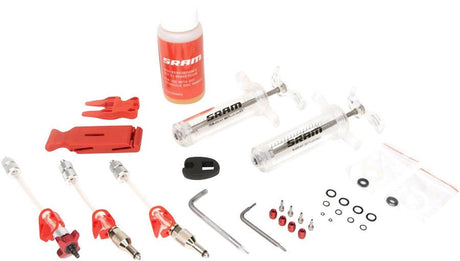Intro
Bleeding brakes is a necessary evil, with just about every frame using internal cable routing for the rear, and some using headset routing for the front. Installing a new set of brakes means introducing bubbles and then pushing them out. Not only that, their performance fades over a few months of hard riding, and the bleed kit emerges from the toolbox once again. A crisp bleed instills confidence on the bike like nothing else, and learning the art of bleeding brakes is a must for any hard charging home mechanic. SRAM’s bleed kits are the perfect tool for purging bubbles from your brakes, keeping that pesky bite point in check.
When you’re buying a new set of brakes, you’ll need to buy a bleed kit, and you have a couple of options. If your new SRAM brakes have mineral oil inside their lines, you’ll get a mineral oil kit. If your brakes use DOT fluid, you’ll get a DOT fluid kit, and I hope that’s self explanatory enough. The two are very similar, but use different seals that are designed to put up with their respective fluids more optimally. SRAM offers a Pro and Standard version for both mineral oil brakes and DOT fluid brakes, with only small differences between them. In this article, we’ll help you choose between the Pro and Standard kit, explaining the differences between them, and why you might want one over the other.
Pro kit on the left, Standard kit on the right
Similarities
First, let’s look at what’s the same in both kits. Both the Pro and the Standard bleed kits will give perfect bleeds when used correctly, and poor bleeds if used incorrectly. You’ll need to care for them the same, cleaning them after each use and not leaving them exposed to direct sunlight during storage. Plastic syringes and rubber o-rings will lose their seal very quickly if you don’t take good care of them, regardless of which kit you buy. Included with each kit is enough brake fluid for a few bleeds, pad spacers you’ll use during the bleed, a couple wrenches, four sets of olives and barbs, spare seals, a crowfoot tool, two syringes, two standard fittings, and one Bleeding Edge Fitting.
Bleeding techniques with both of these kits are identical, and we strongly recommend that you follow SRAM’s Bleeding Edge Brake Bleed tutorial video when completing this service at home.
Higher quality syringes and fittings, is it worth it?
Differences
The only differences between a Pro and a Standard SRAM Bleeding Edge kit, is the syringe and material used in the fittings. A Pro Bleed Kit has a higher quality syringe, with a more ergonomic lever, higher quality plastic, and a serviceable seal in the piston. There is less friction in the Pro syringe, allowing for more precision when bleeding the brake, and the ergonomics of the handle make it easier to pull a vacuum on the system. On the outside of the syringe are hash marks, making it easy to see the exact quantity of oil in the syringe.
The Standard syringe is far more basic, with more friction in the system, a less ergonomic shape, and a non serviceable seal in the piston. You’ve probably seen this exact syringe in other applications, maybe in the kitchen or somewhere else, as these syringes can be bought in bulk.
The fittings of the Pro kit are metal, giving a more secure feeling connection between the syringe and the fittings. Because they’re metal, there are extra o-rings in the Pro kit fittings, and extras are supplied in the kits.
Compatibilities
SRAM DOT fluid bleed kits aren't compatible with just SRAM brakes, and they're our number one recommendation for Hayes Brakes as well. Hayes' own bleed kit does work of course, but it's not as refined as SRAM's kit. When using the SRAM bleed kit on Hayes brakes, you'll use the two regular fittings, not the bleeding edge fitting. Then you'll just bleed the Hayes brake according to their tutorial, but with nicer equipment.
SRAM's Bleed Kits are my tool of choice for either of these brakes.
Which is better for you?
Like most choices we make as consumers, it comes down to value. You can get the exact same bleed using the same technique with both kits, so why would you get the Pro kit over the more affordable Standard kit? Well, the syringes used in the Pro kits are much nicer to use. Requiring less effort to push and pull the plunger allows you to make minute adjustments while coaxing bubbles out of the system.
The Standard DOT fluid kit costs $83, and the Pro DOT Fluid kit is $106, about 27% more expensive. There’s a bigger difference for the mineral oil kits. Standard kits cost $74, and the Pro kits cost $127, a 72% difference. I think the nicer syringes are worth spending 27% more, but not 72%.
Because of that difference in price, I would recommend getting the Pro kit if your brakes use DOT fluid, but I think it makes more sense to get the Standard kit if your brakes use mineral oil.
That’s where my personal valuometer lands, but that’s not to say you shouldn’t get the Standard DOT fluid kit or Pro mineral oil kit. No matter which kit you get, make sure to store it appropriately, never cross-contaminate fluids, and clean it after every use to make sure it lasts as long as possible. That’s where the real value is.





